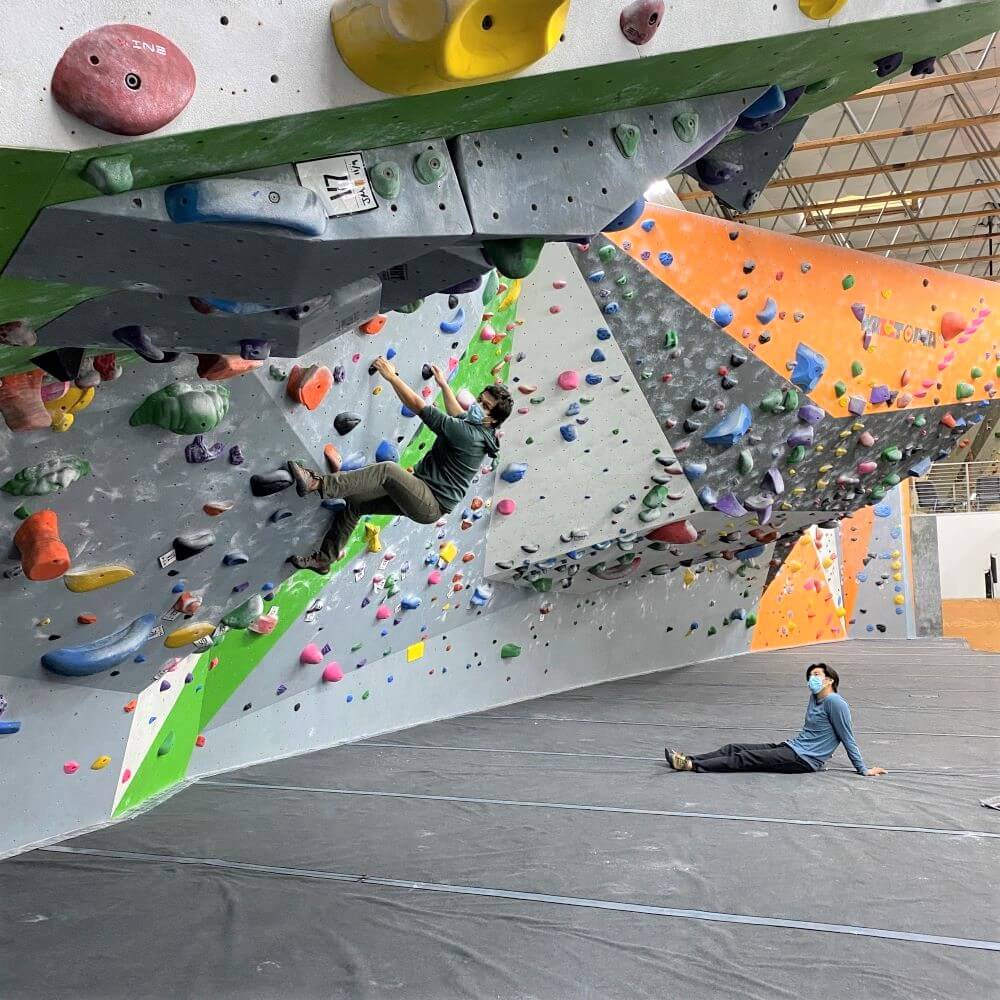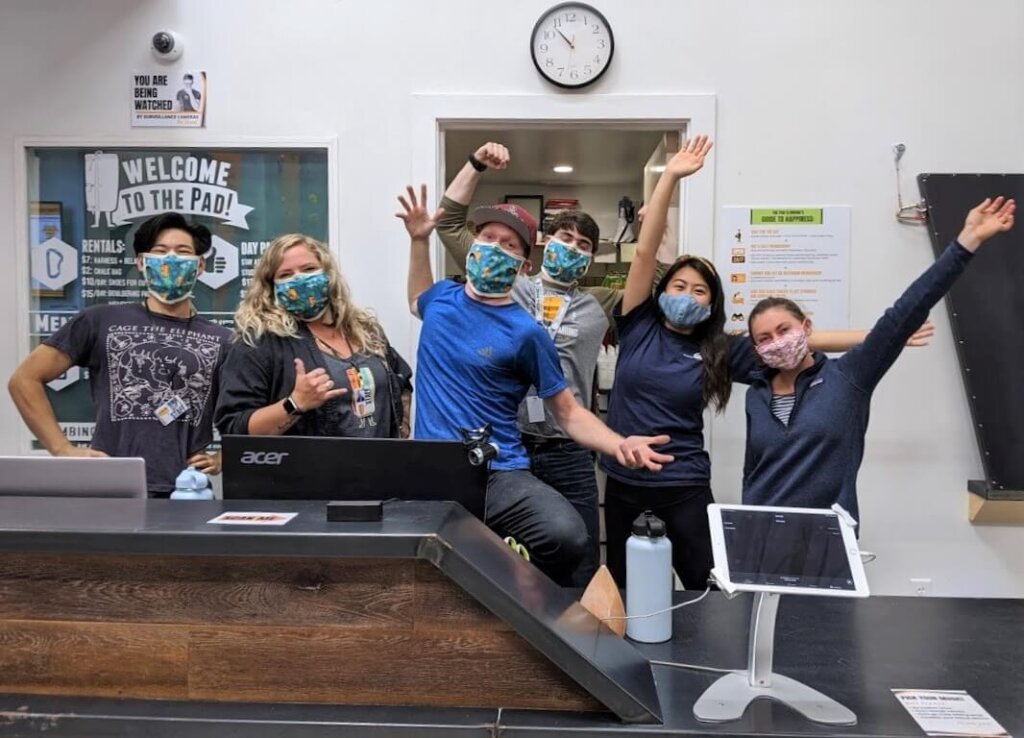The Pad Climbing Gym started out nearly twenty years ago as the country’s first nonprofit bouldering gym, but it took until the pandemic for co-founders Kristin and Yishai Horowitz to get their business where they’ve always wanted it to be. Between running multiple businesses and training her dogs, we found time to sit down with Kristin and learn more about what accessibility means at The Pad, the difference between rock climbing and bouldering, and why being Green Business Network certified is important to their mission.

First things first, how did the Pad Climbing get its start?
We started out as SLO Op, the country’s first nonprofit bouldering gym — a project between my now husband, Yishai, and a few dedicated climbers in the early aughts. I came back to SLO for grad school and ended up helping them all with operations. He and I slowly grew the community, moving location to location, physically building the walls with that community, until it was clear we needed to become a full-commercial gym before someone else did — and here we are.
You’ve been involved in numerous ventures and businesses around our community. What drives your passion?
I have unbridled enthusiasm to bring out other’s potential. I taught English at Poly and Hancock and giving people voices and new experiences through language is my passion. However, the events we put on through All Out Events and the experiences I’ve had both climbing and working at the climbing gyms harnessed that and became my focus. Peak experiences with others do the same thing — it connects, it empowers, and it drives people to believe more in themselves than they did.
What is your favorite outdoor activity?
Surprisingly, it’s working my dogs on cattle and sheep. I’m rabidly passionate about the Australian Shepherd and developing their potential. I want to see them more in use on ranches that need what they have to offer. I also just really like hooved animals (I went to Poly for Animal Science), so taking care of them and understanding them along with working with my dog buddy to manage them is something that feels like it’s in my blood.

Favorite place to climb outdoors?
Red Rocks, NV (yay for us having a location in Vegas too) and also the Red in Kentucky. Locally, you can’t beat going out to Bishop’s Peak for a low key time with friends you might not have met yet.
Who can come workout at the Pad?
Literally anyone. Whatever is holding you back from trying it, we are here to make you comfortable and perhaps have that same life changing experience I and others have felt. We have accommodations for the disabled, harnesses for pregnant women, our coaches are certified to work with those on the spectrum, and we have a number of amputees as members.
For someone who’s never been to a climbing gym before, what do they need to know?
Wear something comfortable that makes you also feel awesome: including confidence in yourself. It can be intimidating because people might be better than you or the walls might be higher than you’re comfortable with. We have a page on our website that outlines what your first experience will be and if you need more, definitely ask the front desk. They will be psyched to get you up your first route, or show you someone in the community here who will.

What’s the difference between rock climbing and bouldering?
They’re the same. Back in the day, people went up big mountains with ropes and that’s what we all think of as rock climbing. They hammered pins into the wall and held onto them (aid climbing) and then slowly didn’t anymore, putting in bolts and removable gear (free climbing). Some people climb without any protection (free soloing).
Bouldering started out as a rest day activity that people specialized into a sport on its own. It’s basically climbing (generally) shorter routes without ropes. In the gym, we have really high foam pads installed to catch you, whereas if you’re on the rope side, it’s a thinner pad because you’re secured with ropes.
Anything you’ve changed (personally or professionally) over this past year you hope will be permanent?
Oh wow, everything changed. There was so much fear and uncertainty, but we lived our values and kept our full time staff employed even though we were closed 10 of the past 14 months. But, we were able to take that time to re-evaluate how everything worked and our team is now a family that I rely on where before it was largely my husband and I trying to lead everything and handle it all. All of us coming together to really walk the walk is the thing I want to hold onto.
Our company is now exactly where I’ve wanted it to be all this time with a number of people standing shoulder to shoulder with us. I also founded a coalition of indoor climbing centers in California and have broadened my network to people I never had access to. I am helping them recover and look to the future, and I definitely want to keep that up.
The Pad is in the Green Business Network — why is it important for you to have that certification?
While I want the physical space of the Pad to feel as neutral and peaceful as the forest we’d find ourselves in if we were climbing outside, we also want to lead the community and industry in taking care of our community — the people, the environment, all of it. Being green means making choices that might not be the cheapest, but it lives the values we have.
We’re excited to have gone solar in the last year in a rented space, thanks to a supportive landlord, and we’re constantly looking for ways to reduce waste and our footprint. The certification isn’t so important, but it was a great blueprint for our staff to hit goal posts. I also use the B Corp Certification guide to steer our business practices, though I’m not sure we’ll ever get that certification (even though we qualify) because we’d have to do some reclassification that I can’t justify the time and finances on. The paperwork isn’t important, it’s the practices that are.

One last question…why should our community support local?
The local community is where our choices really have impact. We can get so invested in what’s happening globally or nationally, but we have so little direct influence on that.
Through the pandemic, I worked with so many local business owners to get them help filing for aid or adapting to the pandemic, we received a SLO City Small Business Relief grant where we got none at any other level, and my neighbors and I got so much closer than we’d ever had. That daily person-to-person lived experience is where ideas form, partnerships meld, and relationships foment. We wouldn’t be here today if a good portion of our local community didn’t maintain their memberships with no expectation of anything in return. It means we did something for them that when they had a choice to spend money elsewhere, it was us they chose to support.
Supporting locally-owned businesses means that your neighbor can continue to invest in your community in the same way or in even broader ways — we are so fortunate to have the beautiful community we have here, and if we don’t take care of one another, things will change — and we’ll be even more isolated than when we were all staying at home last year.